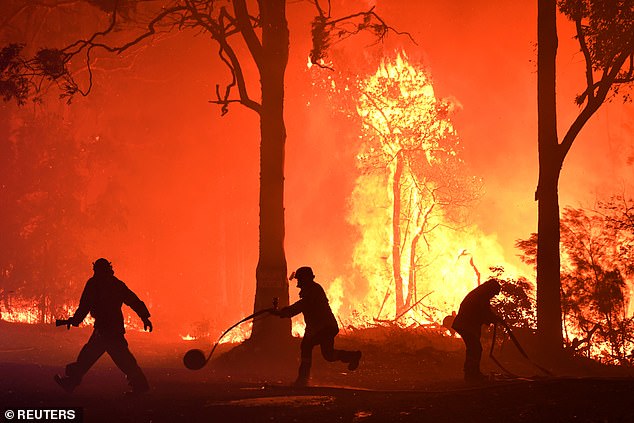Abrupt intensification of northern wildfires due to future permafrost thawing – “These climate conditions lead to rapid intensification of wildfires in western Siberia and Canada in the mid-to-end of the 21st century”
![Atmospheric and wildfire responses to soil moisture reduction in the idealized experiments using the CESM2. The values represent differences between the response of a 40% soil moisture reduction perturbation experiment in July 2045 and a control simulation: (a) soil moisture in 0–10 cm depth (units: kg/m2), (b) surface air temperature (units: °C), (c) relative humidity at 2 m (units: %), and (d) logarithm of burned area [log (burned area)] (units: km2). Time evolution over Western Siberia (65.5°N, 83.75°E): (e) soil moisture over 0–10 cm depth (units: kg/m2), (f) surface air temperature (units: °C), (g) relative humidity at 2 m (units: %), and (h) logarithm of the burned area [log (burned area)] (units: km2) (blue: control simulation, yellow: 20% soil moisture reduction perturbation experiment, and brown: 40% soil moisture reduction perturbation experiment). Graphic: Kim et al., 2024 / Nature Communications](https://desdemonadespair.net/wp-content/uploads/2024/10/image-18.png)
25 September 2024 (IBS Center for Climate Physics) – A study, published in the journal Nature Communications by an international team of climate scientists and permafrost experts shows that, according to new climate computer model simulations, global warming will accelerate permafrost thawing and as a result lead to an abrupt intensification of wildfires in the Subarctic and Arctic regions of northern Canada and Siberia.
Recent observational trends suggest that warm and unusually dry conditions have already intensified wildfires in the Arctic region. To understand and simulate how future anthropogenic warming will affect wildfire occurrences, it is important to consider the role of accelerated permafrost thawing, because it strongly controls the water content of the soil – a key factor in wildfire burning. Recent climate models did not fully consider the interaction between global warming, northern high latitude permafrost thawing, soil water and fires.
Our key finding is that the rapid permafrost thaw results in an abrupt reduction in soil moisture, an increase in surface air temperature and a decline in relative humidity across the Arctic-subarctic region. These climate conditions lead to rapid intensification of wildfires in western Siberia and Canada in the mid-to-end of the 21st century.
Dr. In-Won Kim, lead author of the study and postdoctoral researcher at the IBS Center for Climate Physics in Busan, South Korea, to Newsweek
The new study uses permafrost and wildfire data generated by one of the most comprehensive earth system models – the Community Earth System Model. It is the first model of its kind, which captures the coupling between soil water, permafrost and wildfires in an integrated way. To better separate the anthropogenic effect of increasing greenhouse gas emissions from naturally occurring variations in climate, the scientists used an ensemble of 50 past-to-future simulations covering the period from 1850-2100 CE (SSP3-7.0 greenhouse gas emission scenario), which was recently conducted by scientists from the IBS Center for Climate Physics, Busan (South Korea) and the National Center for Atmospheric Research in Boulder, Colorado (United States) on the IBS supercomputer Aleph.
With this ensemble modelling approach, the team demonstrated that by the mid to late 21st century anthropogenic permafrost thawing in the Subarctic and Arctic regions will be quite extensive. In many areas, the excess soil water can drain quickly, which leads to a sudden drop in soil moisture, subsequent surface warming and atmospheric drying (Figure 1). “These conditions will intensify wildfires,” says Dr. In-Won Kim, lead author of the study and postdoctoral researcher at the IBS Center for Climate Physics in Busan, South Korea. “In the second half of this century, our model simulations show an abrupt switch from virtually no fires to very intensive fires within just a few years” she adds.
These future trends will be further exacerbated by the fact that vegetation biomass is likely to increase in high latitude areas due to increasing atmospheric CO2 concentrations. This so-called CO2 fertilization effect therefore provides extra fire fuel.

“To better simulate the future degradation of the complex permafrost landscape, it is necessary to further improve small-scale hydrological processes in earth system models using extended observational datasets,” says Associate Prof. Hanna Lee, co-author of the study at the Norwegian University of Science and Technology, in Trondheim, Norway.
“Wildfires release carbon dioxide, and black and organic carbon into the atmosphere, which can affect climate and feed back to the permafrost thawing processes in the Arctic. However, interactions between fire emissions and the atmospheric processes have not been fully integrated into earth system computer models yet. Further consideration of this aspect would be the next step,” says Prof. Axel Timmermann, co-author of the study and director of the ICCP and Distinguished Professor at Pusan National University.
Contact
- For further information or to request media assistance, please contact: U-Jeong Seo, IBS Center for Climate Physics, Pusan National University (+82-51-510-7328, u_jeongs@pusan.ac.kr)
Abrupt intensification of northern wildfires due to future permafrost thawing

Abrupt increase in Arctic-Subarctic wildfires caused by future permafrost thaw
ABSTRACT: Unabated 21st-century climate change will accelerate Arctic-Subarctic permafrost thaw which can intensify microbial degradation of carbon-rich soils, methane emissions, and global warming. The impact of permafrost thaw on future Arctic-Subarctic wildfires and the associated release of greenhouse gases and aerosols is less well understood. Here we present a comprehensive analysis of the effect of future permafrost thaw on land surface processes in the Arctic-Subarctic region using the CESM2 large ensemble forced by the SSP3-7.0 greenhouse gas emission scenario. Analyzing 50 greenhouse warming simulations, which capture the coupling between permafrost, hydrology, and atmosphere, we find that projected rapid permafrost thaw leads to massive soil drying, surface warming, and reduction of relative humidity over the Arctic-Subarctic region. These combined processes lead to nonlinear late-21st-century regime shifts in the coupled soil-hydrology system and rapid intensification of wildfires in western Siberia and Canada.
Abrupt increase in Arctic-Subarctic wildfires caused by future permafrost thaw


